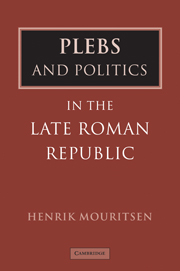2 - The scale of late republican politics
Published online by Cambridge University Press: 22 September 2009
Summary
The scale of political participation in the late republic may be approached from several angles. The physical setting for the assemblies may provide an important indication as to the level of attendance possible in these meetings. Likewise, there are scattered literary references to the number of voters and the size of crowds; this evidence will also be evaluated in this chapter.
The people convened in a number of locations in Rome during the late republic: in the Comitium, the Forum Romanum, the Saepta, the Circus Flaminius and on the Capitol. The first three venues will be discussed in some detail in the following. The old Comitium, located in the northwest corner of the Forum Romanum, was the traditional meeting place for the tribal assembly and for the contiones, non-decisionmaking meetings called by a magistrate. Little survives of the Comitium, and although modern reconstructions differ substantially, there is broad agreement on the overall scale of the site.
Coarelli reconstructed the Comitium as a circular area surrounded by a cavea. Exactly to the north was located the senate building, the Curia Hostilia, which had access through the Comitium area. The entire structure measured 46 metres in diameter, the central area itself being 30 metres across. However, large sections of the cavea, which was approximately 8 metres wide were not available for the crowds who, standing, attended the assembly. The Curia would have intersected the cavea, dividing it into two wings, or cornua as the sources describe them.
- Type
- Chapter
- Information
- Plebs and Politics in the Late Roman Republic , pp. 18 - 37Publisher: Cambridge University PressPrint publication year: 2001



